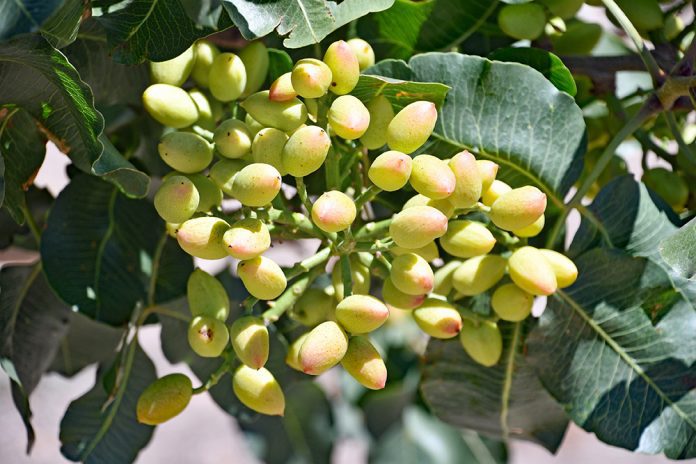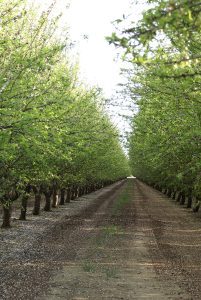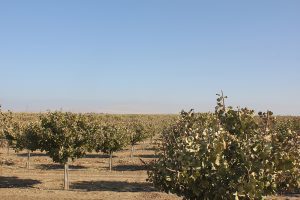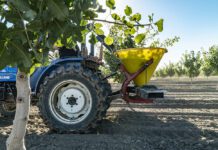
Prompted by new European Union (EU) import thresholds for a food contaminant, the pistachio industry is funding research to gain a better understanding of the causal fungal agents and potential management.
Now in its third year, the work led by UC Davis Plant Pathologist Themis Michailides and his post-doctoral fellow, Pummi Singh, has found a few Aspergillus fungal isolates collected from state orchards produced ochratoxin A above EU thresholds in laboratory tests. But the vast majority did not.
In addition, he said an atoxigenic Aspergillus flavus strain used to manage aflatoxin-producing strains of the same fungus appears effective in lab studies against species responsible for ochratoxin A, or OTA as it is abbreviated.
The pistachio industry saw a need to fund this type of research after the EU proposed OTA limits in 2020 and implemented them on January 1, said California Pistachio Research Board Manager Bob Klein.
In addition to Michailides’ research, the industry has also done a small amount of work looking at OTA’s prevalence in nuts. Grower samples collected from the 2020 crop found OTA and aflatoxin levels and distribution to be essentially the same, Klein said. 2020 was considered a low aflatoxin year.
“During processing, OTA and aflatoxin showed up in the same kind of nuts, insect damaged and stained,” he said.
Samples from the 2022 crop found OTA levels about half those of aflatoxin.
“How much it will vary from year to year, we don’t know,” Klein said.
In response to EU aflatoxin limits, the Administrative Committee for Pistachios implemented the Pistachio Export Aflatoxin Reporting (PEAR) program in 2018 as a formal control program, Klein said. It tests each 40,000-pound load of U.S.-grown pistachios destined for the EU for aflatoxin levels. With the EU adding OTA thresholds, the PEAR program will also screen for that mycotoxin.
Calling the PEAR program a success for aflatoxin screening, he said it has further lowered EU rejections levels.
“It’s been going for the last several years, and we hardly see rejects out of the EU,” he said. “It happens rarely enough that it’s not a huge concern. But there are still enough positives that it gets our attention really quickly.”

What is Ochratoxin A?
The EU updated its regulations for maximum OTA levels in food based on 2020 recommendations from its European Food Safety Authority. Effective Jan. 1, the new thresholds include 5 parts per billion for pistachios marketed directly to consumers or used as food ingredients. The threshold for pistachios subject to sorting or other physical treatment before being marketed is 10 ppb. The higher threshold reflects additional sorting’s potential to reduce aflatoxins and perhaps OTA levels.
OTA is not a newcomer to the food industry either, with scientists first isolating and characterizing it in 1965. Since then, it has been found as a natural contaminant of moldy food and feed.
OTA also is classified as a mycotoxin, the same group of compounds to which aflatoxin belongs. The International Agency for Research on Center classified OTA as a possible human carcinogen in 1993.
Several species in the genera Aspergillus and Penicillium such as Penicillium verrucosu are known to produce OTA in certain crops.
Many of the Aspergillus species are poorly understood, complicating research into their potential to contaminate foods with OTA. Even within an individual species, some strains are atoxigenic, meaning they don’t produce toxins, while other strains do.
In North America, most of the studies of ochratoxins in crops have focused on P. verrucosum contamination of cereals in cold climates.

Low OTA Prevalence
Since California nut and fig crops have never been reported to contain the high OTA levels found in wheat and other crops, Michailides said they hypothesized that atoxigenic strains dominate ochratoxin-producing species.
As part of the initial two-year study, Singh and Michailides collected samples from tree nut and fig orchards in California as well as from packaged tree nuts purchased in the state. In the nut orchards, the samples were from fruit, leaves, soil or air.
He said they focused on figs and pistachios because they have received EU alerts for those crops but not for almonds.
They isolated 72 fungi from the Aspergillus ochraceus group and Aspergillus alliaceus, grew them on special nutrient-rich media for 10 days and tested for OTA production.
Among the isolates, A. ochraceus and A. melleus were most common. No field isolates of either species produced OTA levels above the 1 ppb detection level. But all the A. alliaceus isolates produced OTA, with levels up to 30 ppb.
Nevertheless, A. alliaceus is relatively rare compared to the more common A. ochraceus and A. melleus, leading Michailides to predict a very low probability for OTA contamination. Another fungal group in North America, A. niger, has not yet been studied about whether it could potentially produce OTA.
But Michailides said other questions remain. They found A. ochraceus and A. melleus in figs, pistachios and pistachio tree litter at about the same frequency as A. flavus, one of the fungi responsible for aflatoxin. But he found it surprising that none of the A. ochraceus and A. melleus isolates produced OTA above the 1 ppb detection level. After all, OTA had originally been isolated from the two fungal species. But perhaps populations of those two fungi found in orchards comprised mostly atoxigenic strains.
Based on the initial research, he said further work should focus on A. alliaceus.
Learning from Aflatoxin Experiences
Fortunately, Michailides said, recent research has shown A. alliaceus is related to A. flavus. As a result, he and Klein said they remain hopeful that information about aflatoxin contamination may be helpful in predicting and preventing OTA contamination as well.
Among the aflatoxin management tools are reducing tree stress, proper irrigation, winter sanitation, properly timed NOW treatments and timely harvests. Another control measure is the use of atoxigenic A. flavus strains to crowd out aflatoxin-producing strains. Initial laboratory experiments show they may also be useful in reducing fungi that produce OTA, Michailides said.
Currently, Aspergillus flavus AF36 Prevail and Afla-Guard, strains that do not produce aflatoxin, are registered for use in pistachios and almonds. The former is produced by the Arizona Cotton Research and Protection Council, a non-profit state agency originally formed to develop the product for cotton growers. The latter is from Syngenta.
Sorghum kernels that have been sterilized so they won’t germinate are coated with the beneficial fungus. The grain serves as a food source and carrier. In laboratory studies, both products reduced OTA similarly with an over 80% reduction when pistachio kernels were co-inoculated with the OTA-producing Aspergillus ochraceous and each of the registered atoxigenic strains.
Applying AF36 Prevail or Afla-Guard changes the fungal composition in the orchard, shifting the population as the safe atoxigenic strains displace potential aflatoxin producers.
Along those lines, Michailides just began studies that examine whether navel orangeworm infestations are tied to OTA as they are with aflatoxin in pistachios.
Early splits, where both the shell and hull split before the bulk of the crop, have been the bane of pest and mold management. By themselves, they can increase aflatoxin contamination by the NOW infestation and creating fungal entry ways to the kernel.
The abnormal nuts attract female NOW, which lay eggs in the kernels and increase overall insect damage. The feeding sites also serve as conduits for mold, including the species responsible for aflatoxin and most likely OTA. In addition, NOW larvae have been found to carry A. flavus spores into the kernel.
“(Early splits) become the Achilles heel of early infestations by NOW and also aflatoxin, and we suspect for ochratoxin, but we haven’t shown that,” Michailides said.











